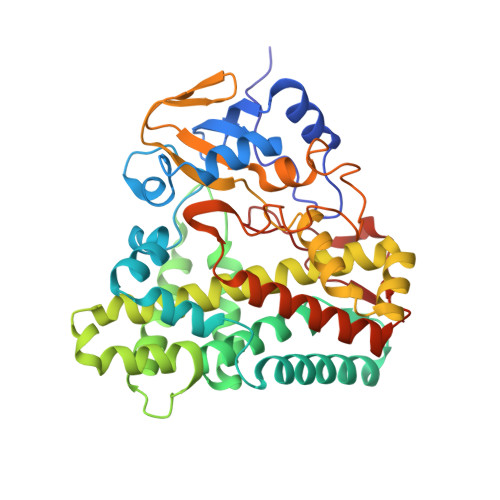Fragment-Based Approaches to the Development of Mycobacterium tuberculosis CYP121 Inhibitors.
Kavanagh, M.E., Coyne, A.G., McLean, K.J., James, G.G., Levy, C.W., Marino, L.B., de Carvalho, L.P., Chan, D.S., Hudson, S.A., Surade, S., Leys, D., Munro, A.W., Abell, C.(2016) J Med Chem 59: 3272-3302
- PubMed: 27002486
- DOI: https://doi.org/10.1021/acs.jmedchem.6b00007
- Primary Citation of Related Structures:
5EDT, 5IBD, 5IBE, 5IBF, 5IBG, 5IBH, 5IBI, 5IBJ - PubMed Abstract:
The essential enzyme CYP121 is a target for drug development against antibiotic resistant strains of Mycobacterium tuberculosis. A triazol-1-yl phenol fragment 1 was identified to bind to CYP121 using a cascade of biophysical assays. Synthetic merging and optimization of 1 produced a 100-fold improvement in binding affinity, yielding lead compound 2 (KD = 15 μM). Deconstruction of 2 into its component retrofragments allowed the group efficiency of structural motifs to be assessed, the identification of more LE scaffolds for optimization and highlighted binding affinity hotspots. Structure-guided addition of a metal-binding pharmacophore onto LE retrofragment scaffolds produced low nanomolar (KD = 15 nM) CYP121 ligands. Elaboration of these compounds to target binding hotspots in the distal active site afforded compounds with excellent selectivity against human drug-metabolizing P450s. Analysis of the factors governing ligand potency and selectivity using X-ray crystallography, UV-vis spectroscopy, and native mass spectrometry provides insight for subsequent drug development.
Organizational Affiliation:
Department of Chemistry, University of Cambridge , Lensfield Road, Cambridge CB2 1EW, U.K.

















